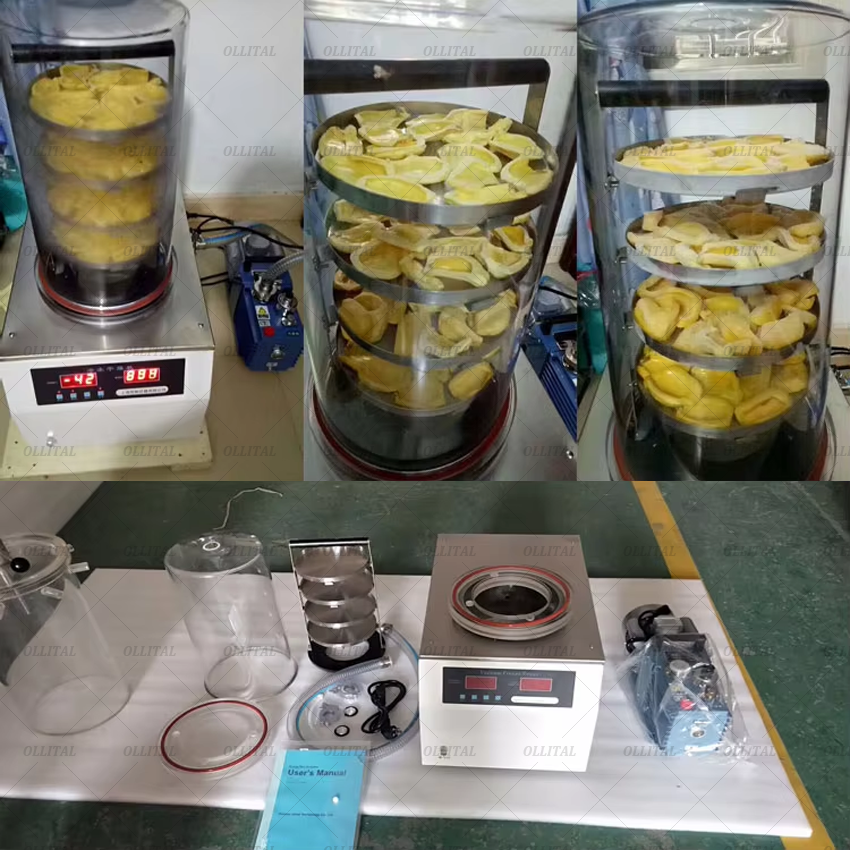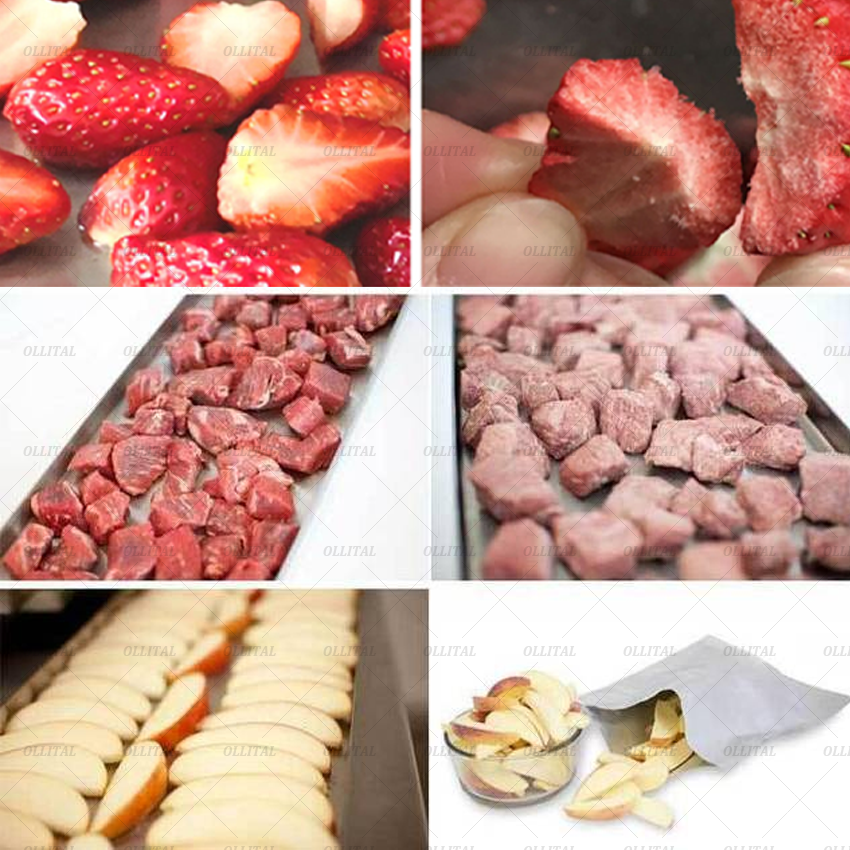Freeze dryer, a highly efficient industrial equipment, is one of the indispensable equipment in the food industry. It effectively removes excess water from various raw materials by using low-temperature freezing technology and vacuum drying process. This process not only reduces the weight of the product, but also retains its original texture, flavor and nutrients to the greatest extent. Since the process does not use high temperature, it can ensure that the product will not undergo any chemical changes or lose active substances during the freezing process, thereby ensuring the quality and safety of high-value products such as medicines and biological products. This technology has a wide range of applications, covering many fields such as food, medicine, biological products and chemicals, providing a unique drying solution for these industries. The freeze drying process is also called freeze drying or sublimation drying to distinguish it from conventional hot air drying technology.
Working principle
The working principle of the freeze dryer mainly includes three stages: freezing, sublimation drying and desorption drying. Core principle: Sublimation. At a certain temperature and pressure, water can directly change from a solid to a gas (sublimation) without passing through a liquid state. This process requires extremely low temperatures to freeze water and vacuum conditions to sublimate ice at lower temperatures.
Freezing stage:
Freeze the material to be treated to a low temperature (usually below -40°C) to freeze its water into ice.
Goal: Freeze the water in the material into solid ice.
Process: Place the material to be treated into the freeze dryer. The freezing system quickly lowers the temperature to below the freezing point of the material (usually -30°C to -50°C or even lower). The water in the material is completely frozen to form stable solid ice, ready for subsequent sublimation drying.
Key technical points: Rapid cooling to reduce the damage of crystalline particles and improve the stability of the product structure.
Sublimation drying stage
When heated in a vacuum environment, ice is directly converted into water vapor (sublimation) without passing through liquid water.
Principle: In a vacuum state, ice is directly sublimated into water vapor by heat supply.
Operation: 1. After freezing is completed, the system evacuates the cavity and reduces the pressure to below the sublimation point. 2. Control the heating device to gradually increase the temperature (usually -10℃ to 0℃). 3. Solid ice is directly converted into water vapor (sublimation) at low temperature and low pressure without passing through liquid water. 4. The water vapor generated by sublimation is captured by the condenser and re-condensed into solid ice to prevent it from flowing back into the material.
Key technical points: 1. Pressure control: Maintain low pressure (several Pa to tens of Pa) through a vacuum pump to improve sublimation efficiency. 2. Heat uniformity: Ensure that the material is heated evenly to avoid insufficient sublimation in some areas.
Desorption drying stage
Further reduce the residual moisture so that the product meets the final drying requirements.Principle: The final drying purpose is achieved by further heating the remaining bound water in the evaporated substance.Operation: 1. Continue to evacuate and reduce the vaporization temperature of the residual moisture. 2. Increase the temperature of the drying chamber (usually 40°C to 60°C) to release the bound water that is difficult to remove in the substance. 3. Remove the trace water vapor generated. 4. Continuously monitor the degree of drying until the moisture content meets the requirements (usually less than 1%-5%).
Key technical points: Appropriately control the temperature to avoid overheating or structural damage of the product. Finally, the product meets the drying requirements for long-term storage.
Key equipment components
Refrigeration system: usually uses compressor refrigeration or liquid nitrogen cooling to freeze the material.
Vacuum system: reduces the pressure in the chamber through a vacuum pump to promote sublimation.
Heating system: controls the temperature increase and provides the heat required for sublimation and desorption drying.
Condensation system: captures the water vapor generated by sublimation to prevent it from affecting the drying process.
Main Features
Freeze dryers have many unique features that make them indispensable equipment in the fields of food, biological products, etc. Low temperature preservation characteristics, light weight, easy storage, rapid rehydration, and maintaining original quality. The following are the specific features of freeze dryers:
1. Efficient removal of moisture
Sublimation drying: Efficient dehydration is achieved by converting moisture directly from solid to gas without going through the liquid water stage.
Through drying: The moisture content of the final product can be reduced to 1%-5%, which helps long-term storage.
2. Product quality remains intact
Maintaining nutrients and activity: Freeze drying is carried out at low temperatures and will not destroy heat-sensitive substances such as vitamins, proteins and enzymes, and can effectively retain their activity.
Stable shape and structure: The freeze-dried product will not shrink or deform, retaining the original shape, color and appearance.
Integrity of flavor and aroma: In food applications, the original flavor and aroma of the freeze-dried product are almost unaffected.
3. Rapid rehydration performance
The interior of the freeze-dried product presents a porous structure (the gaps left by the sublimation of ice crystals), and water can quickly enter during rehydration, almost completely restoring the original state.
4. Improve storage and transportation performance
Lightweight: After the water is removed, the weight of the product is greatly reduced, which is convenient for transportation.
Good stability: The product can be stored for a long time at room temperature, reducing the demand for cold chain.
Microbial inhibition: Low moisture content can effectively prevent microbial growth and chemical reactions, and improve product safety.
5. Adapt to a wide range of materials
Freeze-drying technology is applicable to a variety of substances, such as: Food: fruit, coffee, beef granules, etc. Medicines: vaccines, antibiotics, protein drugs, etc. Biological products: serum, enzymes, strains, etc. Chemical materials: nanomaterials, powders, etc.
6. Precise controllability
Freeze dryers are usually equipped with advanced control systems that can accurately adjust: freezing temperature, vacuum, heating rate, high degree of automation, saving manpower, safe and reliable operation.
7. No pollution, strong environmental protection
No pollution process: The entire freeze-drying process is carried out in a closed vacuum environment to avoid external pollution.
Green process: No chemical desiccant is required, which meets environmental protection requirements.
8. Long-term economic benefits
Reduce waste: Extend the shelf life of the product and reduce losses caused by deterioration.
Multi-functional use: One device can handle a variety of materials, increasing production flexibility.
Main Applications
Freeze dryers are widely used in a wide range of industries, mainly in industries that require high-quality dehydration and long-term storage. The following are specific applications of freeze drying technology in various fields:
1. Food Industry
Freeze dryers are widely used in food processing, especially for products that need to maintain the original flavor, nutrition and structure of food.
Freeze-dried fruits: such as strawberries, blueberries, apple slices, etc., retain the original color and nutrition.
Instant coffee and tea: instant powder made by freeze drying technology, retaining the original flavor and easy to dissolve.
Ready-to-eat food: such as freeze-dried soup, instant noodle ingredients, freeze-dried meat, convenient storage and quick rehydration.
Pet food: freeze-dried pet snacks or staple food, retain nutrition and easy to store.
High-end food ingredients: such as mushrooms, medicinal food materials, etc.
2. Chemical and Materials Industry
In the field of chemistry, freeze dryers are used to prepare materials with high purity or special properties. Nanomaterials: produce high-performance powders that require drying. Chemical reagents: store unstable chemicals to prevent decomposition or deterioration. Catalysts: maintain their structure and chemical activity. Polymer materials: such as biodegradable plastics or medical materials.
3. Biotechnology and scientific research
Freeze dryers are indispensable tools in laboratories and scientific research fields for preserving sensitive samples and experimental materials. Microbial samples: such as strains, yeast, etc., for long-term preservation. Tissue samples: freeze-dry tissues for subsequent research or specimen preparation. Genetic engineering: preserve transgenic samples or protein expression products. Chemical experiments: used to prepare reagents or separate mixtures.
4. Cosmetics industry
Active ingredient preservation: such as freeze-dried masks and essence ingredients, which retain activity and are easy to use.
High-end skin care products: powdered beauty products are produced through freeze-drying technology to extend shelf life and improve quality.
5. Aerospace and military fields
Aerospace food: provide astronauts with nutritious, lightweight, and easy-to-store food.
Military food: field military rations are easy to preserve and quickly restore taste.

